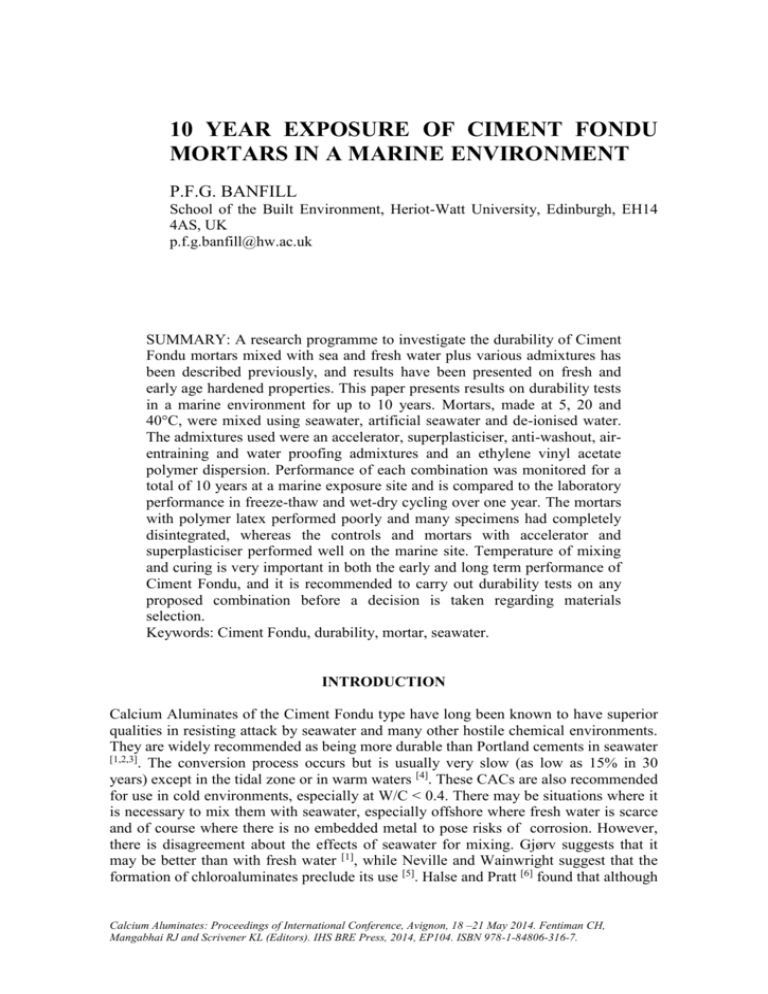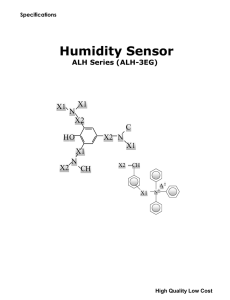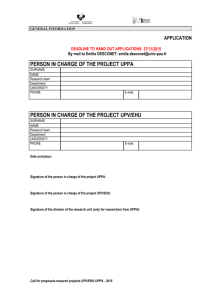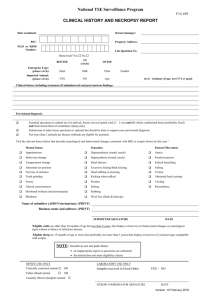Banfill_Final - Heriot
advertisement

10 YEAR EXPOSURE OF CIMENT FONDU MORTARS IN A MARINE ENVIRONMENT P.F.G. BANFILL School of the Built Environment, Heriot-Watt University, Edinburgh, EH14 4AS, UK p.f.g.banfill@hw.ac.uk SUMMARY: A research programme to investigate the durability of Ciment Fondu mortars mixed with sea and fresh water plus various admixtures has been described previously, and results have been presented on fresh and early age hardened properties. This paper presents results on durability tests in a marine environment for up to 10 years. Mortars, made at 5, 20 and 40°C, were mixed using seawater, artificial seawater and de-ionised water. The admixtures used were an accelerator, superplasticiser, anti-washout, airentraining and water proofing admixtures and an ethylene vinyl acetate polymer dispersion. Performance of each combination was monitored for a total of 10 years at a marine exposure site and is compared to the laboratory performance in freeze-thaw and wet-dry cycling over one year. The mortars with polymer latex performed poorly and many specimens had completely disintegrated, whereas the controls and mortars with accelerator and superplasticiser performed well on the marine site. Temperature of mixing and curing is very important in both the early and long term performance of Ciment Fondu, and it is recommended to carry out durability tests on any proposed combination before a decision is taken regarding materials selection. Keywords: Ciment Fondu, durability, mortar, seawater. INTRODUCTION Calcium Aluminates of the Ciment Fondu type have long been known to have superior qualities in resisting attack by seawater and many other hostile chemical environments. They are widely recommended as being more durable than Portland cements in seawater [1,2,3] . The conversion process occurs but is usually very slow (as low as 15% in 30 years) except in the tidal zone or in warm waters [4]. These CACs are also recommended for use in cold environments, especially at W/C < 0.4. There may be situations where it is necessary to mix them with seawater, especially offshore where fresh water is scarce and of course where there is no embedded metal to pose risks of corrosion. However, there is disagreement about the effects of seawater for mixing. Gjørv suggests that it may be better than with fresh water [1], while Neville and Wainwright suggest that the formation of chloroaluminates preclude its use [5]. Halse and Pratt [6] found that although Calcium Aluminates: Proceedings of International Conference, Avignon, 18 –21 May 2014. Fentiman CH, Mangabhai RJ and Scrivener KL (Editors). IHS BRE Press, 2014, EP104. ISBN 978-1-84806-316-7. Banfill seawater retarded hydration the later microstructure was very similar to that with fresh water. In view of the relative scarcity of information on its durability when admixtures are used [3], a research programme was established to investigate the durability of Ciment Fondu mortars mixed with sea and fresh waters, incorporating various admixtures, with the aim of giving information on the effects of the admixtures when the mortars were exposed to laboratory conditions and in a marine environment. Information on the effects on fresh properties [7], early age properties [8] and three-year field performance [9] has already been reported. This paper reports data on field performance up to the conclusion of the investigation after 10 years. EXPERIMENTAL PROGRAMME Materials Ciment Fondu, provided by Lafarge Aluminous Cement Co Ltd (now Kerneos), from a single batch with the chemical and physical properties shown in Table 1, was used with a siliceous sand whose particle size distribution is shown in Table 2. Three different mixing waters were used (Table 3): deionised water (DI), water from the Irish Sea, settled but unfiltered, (SW) and reconstituted seawater (RSW) made from a corrosion test mixture (BDH Chemicals). To simulate the effect of using unwashed marine sand, each mix was also repeated using additional sea salts (SS) added at 6.6 kg of corrosion test mixture per kg of sand, giving mixes designated DI+SS, SW+SS and RSW+SS. Admixtures were chosen to represent a range of types potentially used in marine work and were used at the maximum dosage recommended by the respective manufacturers: Lithium citrate accelerator at 0.025% by mass of cement (Accel) Superplasticiser (FEB SP3) at 0.6% by mass of cement (SP) Anti-washout (Conplast UW) at 1% by mass of cement (AWO) Air-entrainer (Cormix AE1) at 45ml/50kg of cement (AEA) Waterproofer (Palace Intrapruf) at 1:30 in the mixing water (WP) Ethylene vinyl acetate dispersion polymer (Vinamul 3281) at 5% solids by mass of cement (EVA). Table 1. Chemical and physical properties of the Ciment Fondu Setting time (BS915), minutes Initial 280 Final 293 90 micron residue (%) 3.8 2 Blaine surface area (m /kg) 276 Chemical composition (%) SiO2 Al2O3 Fe2O3 FeO TiO2 CaO Na2O K2O SO3 CO2 4.14 38.67 10.43 5.63 1.98 38.5 0.06 0.04 0.19 0.42 Table 2. Particle size distribution of the sand Sieve size 2.4-1.2 mm 1.2-0.6 mm 600-300 μm 300-150 μm 150-90 μm % by mass 25.9 37.1 14.8 14.8 7.4 10 year exposure of Ciment Fondu mortars in a marine environment Table 3. Composition of sea waters (ppm by mass of each species Cl- Na+ SO42- Mg2+ Ca2+ K+ CO32- Br- Sea Water (SW, Irish Sea) 19000 10500 2650 1350 400 380 160 65 Reconstituted (RSW) 16200 9960 1830 570 440 - - - Species Mixing and curing The mix proportions were standardised for every mortar at water/cement ratio 0.40 and cement/sand ratio 0.50, giving overall contents of cement 691 kg/m3, sand 1382 kg/m3 and water 276 kg/m3. There was no reduction in water content to take account of the effect of any admixture. The cement, sand and water were pre-conditioned to the temperature of curing (5, 20 or 40°C). Each batch was made in two parts in a bench top mixer (Kenwood Chef), mixed dry for 60 sec at 120 rev/min, followed by addition of the water and admixture over 60 sec with hand mixing, and a final 60 sec of mixing at 250 rev/min, followed by hand blending of the two parts. 75 mm cubes, 40 mm diameter x 100 mm long cylinders and 40 x 40 x 160 mm prisms were cast and all specimens were cured for 7 days under thermostatically controlled fresh water at 5, 20 and 40°C. This resulted in a factorial experiment consisting of 126 combinations – 7 (Control (Nil) plus 6 admixtures) x 6 (3 waters plus 3 with additional sea salts) x 3 temperatures. Test methods In addition to the laboratory programme of wetting/drying and freezing/thawing reported previously [9], one prism of each mix was set up in an exposure trial which ran from January 1989 for ten years. The specimens were secured in wire baskets at midtide level on a rocky beach on the Irish Sea coast and tested at intervals for ultrasonic pulse velocity (UPV) using the PUNDIT instrument, for length change by a 100 mm gauge length Demec instrument, weight change and final strength (flexure on each prism followed by compression on 40 mm cubes cut from the broken halves of the prism tested for flexural strength). RESULTS While a large amount of data was accumulated, only the most significant features can be presented here, and appropriate comparisons will be made with laboratory data. Analysis of variance enabled statistical significance to be established for the relevant factors. Unfortunately, many specimens were lost or became unidentifiable during the course of the trial between 4 years and 10 years, and this seriously restricts the amount of 10 year data that can be shown: only 31 out of 126 combinations are available. UPV Figs. 2-7 show changes in UPV with time for each admixture compared to the nil mix (Fig. 1). Because a constant w/c ratio was used, these trends show the effect of the admixtures without any confusing factors. The results designated ‘lab’ are taken from the laboratory freeze/thaw results [9], wherein each 40 x 40 x 160 mm prism was immersed 100 mm deep on its long dimension in sea water and then subjected to 120 Banfill cycles of alternate -5°C and +20°C over one year. The temperatures shown are the temperature of mixing / casting and each point is the mean of 6 specimens prepared with the different mixing waters. The results designated ‘site’ were obtained from different specimens cast at the same time and are likewise the means of the 6 specimens prepared with the different waters, but some 10 year (approximately 3400 days) results are based on only one or two specimens due to the losses mentioned above. Since the previous results had shown no significant effect of the mixing water type on the performance of the mortars [9], this process is considered to give representative comparisons. UPV (v) is a reasonable predictor of cube strength (fcu), as shown by equation 1 which was constructed from the 10 year test results obtained in this investigation using 60 points (made up of 31 identifiable and 29 unidentifiable but still testable specimens). There are too few 10 year strength values to be presented here. UPV - km/sec fcu = 0.07 v4 ± 11.0 (1) 5.50 5.30 5.10 4.90 4.70 4.50 4.30 4.10 3.90 3.70 3.50 5 degC (lab) 20 degC (lab) 40 degC (lab) 5 degC (site) 20 degC (site) 40 degC (site) 1 10 100 1000 10000 Age - days Fig. 1: Effect of exposure (lab up to 1 year, site up to 10 years) on UPV of Nil mixes cured at different temperatures. 5.50 5.30 UPV - km/sec 5.10 5 degC (lab) 4.90 20 degC (lab) 4.70 40 degC (lab) 4.50 4.30 5 degC (site) 4.10 20 degC (site) 3.90 40 degC (site) 3.70 3.50 1 10 100 Age - days 1000 10000 Fig. 2: Effect of exposure (lab up to 1 year, site up to 10 years) on UPV of Accel mixes cured at different temperatures. UPV - km/sec 10 year exposure of Ciment Fondu mortars in a marine environment 5.50 5.30 5.10 4.90 4.70 4.50 4.30 4.10 3.90 3.70 3.50 5 degC (lab) 20 degC (lab) 40 degC (lab) 5 degC (site) 20 degC (site) 40 degC (site) 1 10 100 1000 10000 Age - days UPV - km/sec Fig. 3: Effect of exposure (lab up to 1 year, site up to 10 years) on UPV of SP mixes cured at different temperatures. 5.50 5.30 5.10 4.90 4.70 4.50 4.30 4.10 3.90 3.70 3.50 5 degC (lab) 20 degC (lab) 40 degC (lab) 5 degC (site) 20 degC (site) 40 degC (site) 1 10 100 1000 10000 Age - days UPV - km/sec Fig. 4: Effect of exposure (lab up to 1 year, site up to 10 years) on UPV of AEA mixes cured at different temperatures. 5.50 5.30 5.10 4.90 4.70 4.50 4.30 4.10 3.90 3.70 3.50 5 degC (lab) 20 degC (lab) 40 degC (lab) 5 degC (site) 20 degC (site) 40 degC (site) 1 10 100 1000 10000 Age - days Fig. 5: Effect of exposure (lab up to 1 year, site up to 10 years) on UPV of WP mixes cured at different temperatures. UPV - km/sec Banfill 5.50 5.30 5.10 4.90 4.70 4.50 4.30 4.10 3.90 3.70 3.50 5 degC (lab) 20 degC (lab) 40 degC (lab) 5 degC (site) 20 degC (site) 40 degC (site) 1 10 100 1000 10000 Age - days UPV - km/sec Fig. 6: Effect of exposure (lab up to 1 year, site up to 10 years) on UPV of EVA mixes cured at different temperatures. 5.50 5.30 5.10 4.90 4.70 4.50 4.30 4.10 3.90 3.70 3.50 5 degC (lab) 20 degC (lab) 40 degC (lab) 5 degC (site) 20 degC (site) 40 degC (site) 1 10 100 1000 10000 Age - days Fig. 7: Effect of exposure (lab up to 1 year, site up to 10 years) on UPV of AWO mixes cured at different temperatures. The 40°C mixes show consistently the lowest UPV in both lab and site exposure because they were already converted at the start of the tests, while the 20°C mixes start highest but typically drop below the 5°C mixes over the one year lab exposure period, also due to conversion. There is no consistent trend between the 5 and 20°C mixes in site exposure and it should be noted that some values are identical at 4 years and the symbols coincide on the graphs: there are no missing points in the 4 year data. In general the site values are what would be expected from extrapolating the lab trends but the UPV of many mixes decreased between one and 10 years. Mass change Most specimens gained mass after exposure to the marine environment, with the exception of about half of those from groups of mixes made at 40°C. Mass loss did not correlate with spalling, most notably with the group of mixes containing waterproofer cured at 40°C, which lost mass but did not spall. This is presumably as a result of developing porosity. Fig. 8 shows the results, averaged over 6 specimens prepared with different mixing waters. 10 year exposure of Ciment Fondu mortars in a marine environment 5.00 5°C 20°C 40°C 5°C 20°C 40°C 5°C 20°C 40°C 5°C 20°C 40°C 5°C 20°C 40°C 5°C 20°C 40°C 5°C 20°C 40°C Mass change - % 0.00 -5.00 Nil Accel SP AEA WP EVA AWO -10.00 -15.00 -20.00 Fig. 8: Mass change at 4 years (means of 6 specimens made with different mixing waters). Dimensional change Establishing reliable trends of expansion and contraction is difficult because many specimens lost their Demec spots during the exposure trial: only a few spots remained after 10 years. Most 5°C cured specimens expanded over time and most 40°C specimens contracted. Visual inspection All the severe spalling occurred in the 40°C mixes and was particularly severe with those made with accelerator and anti-washout admixture: an unidentified expansive chemical reaction occurred but no further information is available. Conversion seems to accelerate spalling as shown by the trend from 5 to 40°C specimens. The only 40°C specimens to completely escape spalling were those containing air-entrainer and waterproofer. Table 4 summarises the condition, as assessed visually, of the specimens at 4 and 10 years. Table 4. Visual condition score of specimens at 4 and 10 years exposure. (Key: 5=sound, 4=slight spalling, 3=significant spalling and/or cracking, 2=extensive deteriorations, spalling, cracking and loss, 1=very little of specimen left.) Mixing temperature 5°C 20°C 40°C 4 10 4 10 4 10 Nil 5 5 5 - 4 - Accel 5 5 5 5 2 - SP 5 5 5 - 4 4 AEA 5 5 4 3 4 4 WP 4 - 5 5 5 5 EVA 4 - 4 4 2 2 AWO 5 5 5 3 1 - Years Admixture Banfill DISCUSSION Tables 5-6 attempt to bring together the test findings relating to the effects of admixtures and mixing temperatures on performance in the marine exposure environment. Just as the visual scores for the nil mixes without admixture (Table 4) are high, so also are the test parameters (Table 5): mortars without admixture performed as well as the best of those with admixture. In contrast, the EVA polymer dispersion performed uniformly badly, while air-entraining agent, waterproofer and anti-washout admixture performed better but still failed to offer protection against spalling, despite performing well in laboratory freeze-thaw testing [9]. Overall, the anti-washout admixture performed less well than the air-entraining agent and the waterproofer, particularly at 40°C. In hindsight, it is possible that the air content or spacing factor were not high enough to enhance the durability of the mortars with air-entraining admixture. A more detailed investigation of this point would be useful in any further work. Mortars with superplasticiser maintained similar strength and durability as those without any admixture, with the sole exception of the 10 year cube strength, which is, however, based on only two specimens. Finally, despite achieving high early strengths, mortars containing accelerator were not more durable than the nil mixes. Temperature of mixing and curing is important in the long term performance of Ciment Fondu mixes (Table 6). Mortars stored at 40°C are highly converted and strength is correspondingly lower. Those at 5°C, with low conversion levels, performed well in the marine environment despite performing poorly in lab durability tests [9]. Additional salt in the mixing water appears not to have any effect although, of course, the risk of corrosion of embedded metal where sea water is used for mixing cementitious materials makes this undesirable. 100 90 28 day cube strength - MPa 80 70 60 50 5 degC 40 20 degC 30 40 degC 20 10 0 -5 -4 -3 -2 -1 0 1 2 3 4 5 Mass change - % Fig. 9: Relationship between 28 day cube strength and mass change at four years. 10 year exposure of Ciment Fondu mortars in a marine environment Table 5. Summary of exposure performance (admixtures). Admixture type Test parameter Nil Accelerator Superplasticiser Air entrainer Water-proofer EVA dispersion Anti-washout UPV 3 years high high high medium medium low UPV 4 years high high high medium medium low UPV 10 years high high high medium medium low Cube strength 10 years (MPa) Flexural strength 10 years (MPa) Length change 4 years Mass change 4 years Mass change 10 years 30-40 (1 specimen) 40-50 25-35 20-35 20-35 20-35 medium but 40°C low medium but 40°C low medium but 40°C low 50 (1 specimen) 1.9 (1 specimen) 1.8-2.0 1.6-3.0 1.1-3.2 1.2-3.2 1.2-2.0 3.0 (1 specimen) none expansion none contraction contraction expansion small expansion gain small gain gain gain gain gain loss - small gain - small gain gain at 5 and 20°C gain Loss (1 specimen) Table 6. Summary of exposure performance (mixing temperatures). Mixing temperature Test parameter 5°C 20°C 40°C UPV 3 years high high medium UPV 4 years high high medium UPV 10 years high high low Cube strength 10 years (MPa) Flexural strength 10 years (MPa) 30-40 20-50 25-50 1.1-3.0 1.2-2.3 1.6-3.3 Length change 4 years expansion EVA and AWO expanded, AEA and WP contracted contraction Mass change 4 years gain large gain Mass change 10 years gain large gain loss except small gain in SP and AEA mixes neutral Fig. 9 shows that, while there is a reasonable positive correlation between 28 day cube strength and mass increase on exposure to the marine environment for higher strength mortars (above about 30 MPa), there is a significant effect of curing temperature. The points on the graph fall into three broad zones, delineated by the dashed lines: (i) mortars cured at 20°C exhibit high strength and mostly a small mass increase, (ii) mixes at 5°C exhibit lesser strength and small mass increase, and (iii) mixes at 40°C achieved strengths of 10-30 MPa and in some cases showed considerable mass loss (there are an additional 8 points offscale with mass loss more than 5%). Presumably strong specimens can resist abrasion, wetting and drying, and freezing and thawing, and continue to gain mass as a result of continuing reactions between cement and water. This suggests that 28 day strength remains a good predictor of durability: mixes with less than about 30 MPa at 28 days are more likely to be non-durable. Furthermore, there Banfill is reasonable qualitative agreement in the UPV against age graphs (Figs. 1-7) between the early stages (up to one year), where laboratory freeze-thaw tests in seawater are shown, and the later stages, showing site exposure. This suggests that laboratory freezethaw results could also be useful to predict field performance. CONCLUSIONS This investigation on mortars exposed to the marine environment shows that the effects of admixtures on Ciment Fondu are complex: potential users should carry out trials of the combinations being considered. Laboratory trials should represent the most severe exposure anticipated. Laboratory freeze-thaw in seawater and 28 day cube strength (cured at the anticipated temperature of exposure) are useful predictors for long term field performance in the marine environment. In general the ethylene vinyl acetate polymer dispersion performed badly, and air-entraining agent, waterproofer and antiwashout admixtures all failed to protect the specimens against deterioration. In fact, it is hard to improve upon the performance of plain Ciment Fondu, possibly with superplasticiser or accelerator, as a binder for marine applications. ACKNOWLEDGEMENTS The experimental assistance of Dr Nina Baker and Tom Scott is gratefully acknowledged, as is the access granted to the exposure site by the Unit for Coastal and Estuarine Studies, University of North Wales, Bangor. The project was made possible by a CASE studentship awarded by the (then) Science and Engineering Research Council and Lafarge Aluminous Cement Co (now Kerneos). I am also grateful to an anonymous referee for helpful comments. REFERENCES [1] [2] [3] [4] [5] [6] [7] Gjorv O E. Long term durability of concrete in seawater. Journal of the American Concrete Institute, Vol. 68, 1971, pp 60-67. George C M. Industrial aluminous cements. In Structure and performance of cements (ed. Barnes P). Applied Science Publishers, London, 1983, pp 415-470. Concrete Society. Calcium aluminate cements in construction: A re-assessment. Technical Report 46. Concrete Society, Slough, 1997. Midgley H G. Penetration of chlorides into hardened cement paste. Cement and Concrete Research, Vol 14, 1984, pp 546-556. Neville A M and Wainwright P J. High alumina cement concrete, Construction Press, London, 1975. Halse Y and Pratt P L. The development of microstructure of high alumina cement. 8th International Conference on Chemistry of Cement. Rio de Janeiro, Vol IV, 1986, pp 317-321. Baker N C and Banfill P F G. Properties of fresh mortars made with HAC and admixtures for the marine environment. Calcium Aluminate Cements: 10 year exposure of Ciment Fondu mortars in a marine environment [8] [9] Proceedings of the Midgley Symposium. (ed. Mangabhai R J). E & FN Spon, London, 1990, pp 142-151. Baker N C and Banfill P F G. The use of admixtures in high alumina cement mortar for the marine environment. 9th International Congress on Chemistry of Cement, New Delhi, Vol IV, 1992, pp 719-725. Baker N C and Banfill P F G. Durability of High Alumina Cement mortars for the marine environment. Durability of Concrete: Proceedings of 3rd International Conference. (ed. Malhotra V M). Nice, 1994, American Concrete Institute, Farmington Hills, USA, SP-145, pp 409-422.








